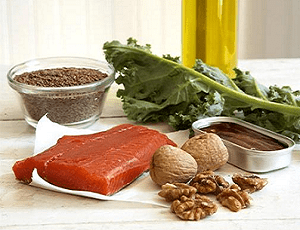Omega 3 and Personal Fitness
People are crazy about keeping fit these days. You see people walking, running, and talking about going to the gym before work. Along with keeping fit, people are using supplements to stay healthy. There are multi-vitamins, protein shakes, and anti-oxidants that benefit the body and overall health. If you are getting in on this fitness craze, don’t forget to include Omega 3 in your personal fitness plan.
Your body needs Omega 3 to help build brain cells, improve circulation, and for overall cardiac health. But an added bonus to Omega 3 is it helps boost your metabolism and increases weight loss. Omega 3 has other benefits including: reducing pain and inflammation and helping lower anxiety and depression. Studies show Omega 3 fatty acids are the basic cells in the brain. It even promotes a healthy immune system, but our diets have long been lacking this essential nutrient. We need to add this fatty acid back into our lives to improve our overall health and fitness!
Take your Omega 3 then Hire your Personal Trainer
 It is a good idea to start taking Omega 3 prior to starting an exercise routine. When you start Omega 3 supplementation before exercise, it will help rev up your metabolism and prepare your body for an exercise routine. Omega 3 also helps to reduce inflammation, so you will have healthier joints and muscles for your workout routine.
It is a good idea to start taking Omega 3 prior to starting an exercise routine. When you start Omega 3 supplementation before exercise, it will help rev up your metabolism and prepare your body for an exercise routine. Omega 3 also helps to reduce inflammation, so you will have healthier joints and muscles for your workout routine.
When you take care of your body prior to beginning your work with a personal trainer, you will be able to withstand the hard workouts he or she puts you through. Omega 3 may increase your sensitivity to insulin, and this will help you build up muscle tissue faster. Body builders benefit from this because it can help them reduce their body fat and get lean faster.
Insulin sensitivity reduces the amount of fat you store and helps you use glucose for energy and the building of muscles. In addition, Omega 3 keeps your blood pressure in a good range and can help you have a more regular heartbeat. This will help your exercise program by preventing you from getting out of breath. It will start helping your cardiovascular health and keep your heart from having to work too hard during workouts. Just remember to check with your physician before starting Omega 3 and a new exercise routine.
Omega 3 Dosage for Workouts
When you start a fitness routine, make sure your body gets the right vitamins and supplements and time them just right. Increase your intake of carbohydrates and protein to give you energy for exercise and feed your muscle. Remember that getting enough nutrients is just as important as the exercise routine itself.
 You can get most of the necessary vitamins from a good multi-vitamin supplement containing vitamin A, D, E, K and B, plus minerals. You will want to take a separate supplement of Omega 3. The proper dosage for Omega 3 depends on whether or not you have any underlying health conditions. If you are healthy, the recommended dosage of Omega 3 is 1,000mg to 3,000mg daily.
You can get most of the necessary vitamins from a good multi-vitamin supplement containing vitamin A, D, E, K and B, plus minerals. You will want to take a separate supplement of Omega 3. The proper dosage for Omega 3 depends on whether or not you have any underlying health conditions. If you are healthy, the recommended dosage of Omega 3 is 1,000mg to 3,000mg daily.
Experts in the fitness industry state anti-inflammatory benefits usually happen at around 2,000mg a day. An added benefit is relief of sore muscles after a workout. The usual recommended dosage is 600mg daily. In order to get the correct dosage for your health status and fitness program, discuss Omega 3 with your doctor. You can also see a sports practitioner for recommendations. With medical advice, you can come up with a fitness and supplement plan that will benefit your body and health.
Conclusion
If you choose to include Omega 3 in your personal fitness plan, you will benefit your workouts and your total body health. Your body will be able to work at its peak during workouts and recover faster. You will get important nutrients that will help speed up metabolism and build muscle faster.

 Subscribe Now
Subscribe Now


 Cardiac Disease
Cardiac Disease

 Diets have largely turned to mostly processed foods and carbohydrates. This in turn robs the nervous system and brain of needed nutrients to function properly. In addition, too many
Diets have largely turned to mostly processed foods and carbohydrates. This in turn robs the nervous system and brain of needed nutrients to function properly. In addition, too many  Inflammation
Inflammation It is recommended to eat at least 2 servings of wild caught cold water fish every week. Fish should be wild caught with the lowest mercury levels possible. Mercury prevents our body from absorbing Omega 3 properly. Eating too much Omega 6 also reduces the proper absorption of Omega 3. If your diet isn’t quite balanced enough, supplements are a good way to get enough Omega 3. If you choose to use an Omega 3 supplement, The American Heart Association recommends taking 1,000mg to 3,000 mg a day. There are some people that must take more than 3,000 mg of Omega 3 daily. Take such an amount only under the advice of a physician.
It is recommended to eat at least 2 servings of wild caught cold water fish every week. Fish should be wild caught with the lowest mercury levels possible. Mercury prevents our body from absorbing Omega 3 properly. Eating too much Omega 6 also reduces the proper absorption of Omega 3. If your diet isn’t quite balanced enough, supplements are a good way to get enough Omega 3. If you choose to use an Omega 3 supplement, The American Heart Association recommends taking 1,000mg to 3,000 mg a day. There are some people that must take more than 3,000 mg of Omega 3 daily. Take such an amount only under the advice of a physician.

 Men who eat a diet rich in Omega 3 have a lower incidence of; dementia, heart disease, cancer, high blood pressure, and even depression. Omega 3 can even help increase the metabolism and boost weight loss efforts. Memory is better and chances of getting
Men who eat a diet rich in Omega 3 have a lower incidence of; dementia, heart disease, cancer, high blood pressure, and even depression. Omega 3 can even help increase the metabolism and boost weight loss efforts. Memory is better and chances of getting 

 When beef cows are fed only grains, they tend to produce 20 parts Omega 6 fatty acids and only 1 part Omega 3 fatty acids. As you can see above, this is too much Omega 6 and unhealthy for the human body. When animals graze on grass naturally, the Omega three ratio is 1 part Omega 3 to 1 part Omega 6. Humans also tend to eat more nuts, flax, seeds, and vegetables that contain higher amounts of Omega 3 fatty acids.
When beef cows are fed only grains, they tend to produce 20 parts Omega 6 fatty acids and only 1 part Omega 3 fatty acids. As you can see above, this is too much Omega 6 and unhealthy for the human body. When animals graze on grass naturally, the Omega three ratio is 1 part Omega 3 to 1 part Omega 6. Humans also tend to eat more nuts, flax, seeds, and vegetables that contain higher amounts of Omega 3 fatty acids. This means decreasing Omega 6 foods such as; animals fed on: grain diets, vegetable oils, sunflower seeds, margarine, sesame seeds, shortening and creamy salad dressing. These are all high in unhealthy fats and throw the Omega balance off.
This means decreasing Omega 6 foods such as; animals fed on: grain diets, vegetable oils, sunflower seeds, margarine, sesame seeds, shortening and creamy salad dressing. These are all high in unhealthy fats and throw the Omega balance off.